|
The
|
THE BURGENLAND BUNCH NEWS - No. 337 November 30, 2022, © 2022 by The Burgenland Bunch All rights reserved. Permission to copy excerpts granted if credit is provided. Editor: Thomas Steichen (email: tj.steichen@comcast.net) BB Home Page: the-burgenland-bunch.org BB Newsletter Archives: BB Newsletters BB Facebook Page: TheBurgenlandBunchOFFICIAL Our 26th year! The Burgenland Bunch Newsletter is issued monthly online. The BB was founded in 1997 by Gerald Berghold, who died in August 2008. |
| Current Status Of The BB: * Members: 3154 * Surname Entries: 9180 * Query Board Entries: 5896 * Staff Members: 14 |
This newsletter concerns: 1) THE PRESIDENT'S CORNER 2) HISTORICAL BB NEWSLETTER ARTICLES: - SOPRON, HUNGARY 3) ETHNIC EVENTS 4) BURGENLAND EMIGRANT OBITUARIES (courtesy of Bob Strauch) |
1) THE PRESIDENT'S CORNER (by Tom Steichen)  This
month's random bits and pieces (Article 1) again begins with a topic we are experiencing here in
the US, economic inflation, but this time it is about inflation in Hungary. We follow that with a bit about a
movement in Austria to allow dual citizenship, something not currently allowed. That is followed by some information
about an interesting political survey held in Austria and another bit about the varying heating subsidies
provided by the Austrian federal states. I then report on two new vital records transcriptions and a new
house-number translation list. This
month's random bits and pieces (Article 1) again begins with a topic we are experiencing here in
the US, economic inflation, but this time it is about inflation in Hungary. We follow that with a bit about a
movement in Austria to allow dual citizenship, something not currently allowed. That is followed by some information
about an interesting political survey held in Austria and another bit about the varying heating subsidies
provided by the Austrian federal states. I then report on two new vital records transcriptions and a new
house-number translation list.Our regular tidbits include the monthly BB Facebook report, book sales, the lack of a recipe (you should consider providing one!) and a humor item. The remaining articles are our standard sections: A Historical BB Newsletter article, Ethnic Events and Emigrant Obituaries (none this month). Inflation in Hungary: Last month I wrote about the high inflation in Austria, where the annualized inflation had climbed to 10.5 percent in September, the highest it has been in 70 years. This prompted me to ask how things were in the other half of the old Austro-Hungarian Empire. To little surprise, things were worse in Hungary in September, with the reported core inflation rate reaching 20.7 percent, up from 18.6% the previous month and 5.5% the previous year. The high inflation level was reported to be due mainly to soaring energy prices, but also the weak forint exchange rate, drought, and supply chain disruptions due to the Russia's Ukraine war. This high inflation caused thousands of Hungarians, including teachers and students, to march
through Budapest on October 23rd, protesting against the government, demanding higher wages, and calling for a curb on the
surging inflation that is eroding incomes. Sabine Goger of Austria created the transcriptions for her personal use but shared them with Richard, and
he suggested I look at them for inclusion on the BB website. I did look and concluded they would be a great addition to the
transcribed records we have there, so I had Richard ask for permission to do so. Sabine agreed and we all get to benefit.
Copyright for the underlying work remains with Sabine. |
2) HISTORICAL BB NEWSLETTER ARTICLES Editor: This is part of our series designed to recycle interesting articles from the BB Newsletters of 10 years ago. While I debated between two articles, I decided on the one about Sopron, Hungary, because I still agree with my opening sentence in that article: Perhaps the most important village relative to Burgenland in "the adjoining areas of former West Hungary," is Sopron. If that isn't reason enough to share it with our new members of the last 10 years, what is? And it is just as good a reason for long-standing members to read it again. Enjoy! THE BURGENLAND BUNCH NEWS No. 226 November 30, 2012 SOPRON, HUNGARY Perhaps the most important village relative to Burgenland in "the adjoining areas of former West Hungary," is Sopron (German: Ödenburg; Croatian: Šopron; Latin: Scarbantia). As I've noted before, we list 77 villages on our BB villages pages that are in current-day Hungary plus 24 more villages elsewhere outside of Burgenland. These villages are listed because they are in near proximity and had social, economic and/or religious ties to villages in current-day Burgenland. Again, perhaps no village had more such ties than Sopron. In fact, during the gestation of Burgenland, it was assumed that Sopron would become the capital due to its somewhat central location, comparatively large size, and pre-existing governmental facilities. However, that assumption would not prove true. 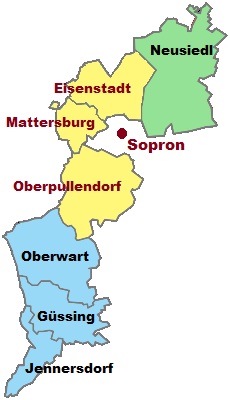 Prior to 1921, Sopron was the county seat of Sopron Megye, having within its county boundaries some 285,000 residents in the seven járás (districts) of Csepreg, Csorna, Felsopulya (now Oberpullendorf), Kapuvár, Kismarton (now Eisenstadt), Nagymarton (now Mattersburg) and Sopron. 49.7% of the county residents were of Hungarian extraction, 38.5% were Germans, 10.9% were Croatians, and the remaining 0.9% were Slovaks, Romanians, Serbians, Ruthenians and others. Religious affiliations were Roman Catholic (84.5%), Lutheran/Calvinist (12.3%/0.3%), Jewish (2.9%), and less than 0.05% of Greek Catholic, Greek Orthodox, Unitarian and other. The city, itself, boasted some 38,000 residents in 1920, being slightly German-dominated (51%), with Hungarians being the other large group (44%). It was also slightly more Lutheran/Calvinist (27.8%/1.2%) and Jewish (6.6%) than the surrounding county, causing the percentage of Catholics to be some 20 points lower, 64.1% (versus the county-wide 84.5%). Sopron was also the governing seat of the 1850s Military District of Ödenburg, one of the five administrative units of the Habsburg Kingdom of Hungary from 1850 to 1860. The district included parts of present-day Hungary, Burgenland, Croatia, and Slovenia that were then the southwestern section of Hungary. Historical Sopron From a historical perspective, Sopron was also one of the key towns in West Hungary, having been inhabited almost continuously since the sixth century BC. Its history is of interest to us Burgenländers as it is a history that we shared. The first permanent settlement in the current-day Sopron area was established by Celtic tribes and located on the Bécsi Hill at the bank of the Ikva creek, probably around the 9th-8th century BC. The first "castles," i.e., soil fortifications, appeared in the 6th-4th centuries BC (Iron Age). The plateau of Várhely was a fortified settlement of Illyrians in the Hallstatt-age. Around 350 BC, the area was reoccupied by the Celts and the building of fortifications and ditches continued until after the first appearance of the Romans. 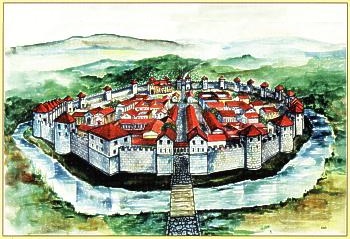 The
first real development of the settlement, however, was a result of the arrival of the Romans during the reign
of Tiberius (14-37 AD). First they established a presence on the nearby hills but later (50 AD) moved into the area of
today's city center, calling the new town Scarbantia. As we've mentioned in past newsletters, the establishment of
Scarbantia was driven by its location at the junction of the Amber Road (going northeast to Carnuntium) with two roads
diverging northwest to Vindobona (Vienna). The Romans filled boggy areas between the streams Ikva and Rák (which is mostly
underground now within the city) and constructed, using pilings, an elliptic fortress with entrances coinciding with today’s
Elokapu (Front Gate) and Hátsókapu (Back Gate) and with walls fortified by several bastions. The main axis of the ellipse
lay along the direction of the Amber Road and the pattern of streets took up the form still visible today in the inner city.
At first glance, building in boggy areas seems to make little sense but, in an era where warfare was fought against
fortified towns by siege machines and tunneling, it was a strong defensive measure. The Roman forum was where the
main square lies today and included the Capitolium (i.e., City Hall) and the Basilica (the venue of judicial and
commercial transactions), around which citizens’ houses were built. An amphitheatre (on Bécsi Hill northwest of town), a
cemetery on St. Michael Hill (north of town) and the pottery workshops (today's Paprét, on the eastern edge of town) also
belonged to the town. The
first real development of the settlement, however, was a result of the arrival of the Romans during the reign
of Tiberius (14-37 AD). First they established a presence on the nearby hills but later (50 AD) moved into the area of
today's city center, calling the new town Scarbantia. As we've mentioned in past newsletters, the establishment of
Scarbantia was driven by its location at the junction of the Amber Road (going northeast to Carnuntium) with two roads
diverging northwest to Vindobona (Vienna). The Romans filled boggy areas between the streams Ikva and Rák (which is mostly
underground now within the city) and constructed, using pilings, an elliptic fortress with entrances coinciding with today’s
Elokapu (Front Gate) and Hátsókapu (Back Gate) and with walls fortified by several bastions. The main axis of the ellipse
lay along the direction of the Amber Road and the pattern of streets took up the form still visible today in the inner city.
At first glance, building in boggy areas seems to make little sense but, in an era where warfare was fought against
fortified towns by siege machines and tunneling, it was a strong defensive measure. The Roman forum was where the
main square lies today and included the Capitolium (i.e., City Hall) and the Basilica (the venue of judicial and
commercial transactions), around which citizens’ houses were built. An amphitheatre (on Bécsi Hill northwest of town), a
cemetery on St. Michael Hill (north of town) and the pottery workshops (today's Paprét, on the eastern edge of town) also
belonged to the town.The Romans did not establish a military base, rather, they created a civilian trading town, inhabited by merchants and veterans, complete with art and culture. During the reign of Vespasianus, between 69-79 AD, the city became a municipium, a city with its own public administration and full civil rights for inhabitants. The ruins of 73 villa-farms have been found in the area and also remnants of wine-grape cultivation, handicrafts production and other commerce from this time. The settlement thrived in Roman times but suffered during the Pannonian tribal migration period. Successive invasions by German tribes, Huns, Eastern Goths, and Lombards all took their toll until the fortress city became nearly uninhabited and largely fell into ruin in 586 when the Avars drove out or destroyed the remaining Christians and Romanized inhabitants. However, the town does appear again in written records as Ödenburg in 856, when it was noted for the red wine produced there. Nonetheless, it would not begin to truly revive until after the Hungarian Conquest (about 900) when King Stephen built a border fortress on the ruins of Ödenburg's/Scarbantia's Roman walls, which were still 5-6m high. Construction of houses started within and at the foot of the castle walls and the line of the streets followed that of the walls: this resulted in an elliptic town centre with two squares, the Main Square (the former Forum) and the Salt Market (today’s St. Ursula Square). During this period, the settlement was referred to, in Hungarian, as Suprun, named after a castle steward named Suprun, or, in Latin, as Castellum Cyperon. 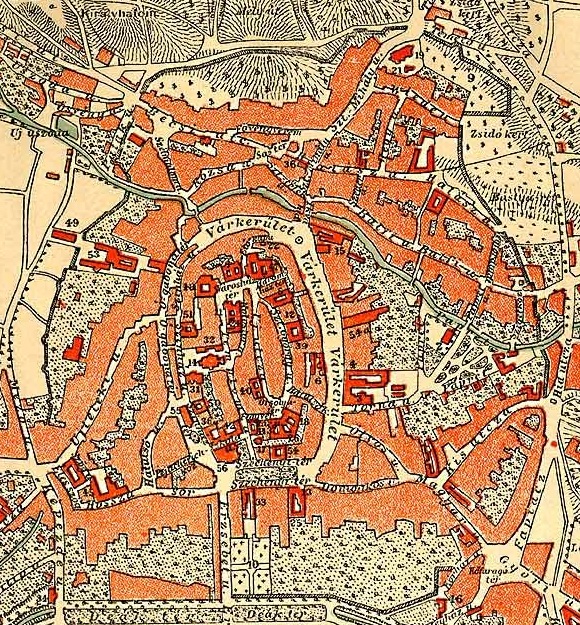 Year
1277 marked another turning point for the town, one still commemorated in the Fountain of Faith memorial: King Otakar
II of Bohemia had occupied the castle several times and, in order to ensure the town’s fidelity, took as hostages the
children of Sopron's nobility. However, when the army of King László IV of Hungary arrived in 1277 to reclaim the city, it
opened its gates gladly, even though doing so cost the lives of their children. The king rewarded Sopron for its fidelity
and loyalty to the Crown by granting it the rank of free royal town (one of only seven) and giving them border guard royal
archers. A statue of Judge István, the first known judge of Sopron, and also the first to express his loyalty to the
Hungarian crown, symbolizes the 1277 event in the Fountain of Faith. Year
1277 marked another turning point for the town, one still commemorated in the Fountain of Faith memorial: King Otakar
II of Bohemia had occupied the castle several times and, in order to ensure the town’s fidelity, took as hostages the
children of Sopron's nobility. However, when the army of King László IV of Hungary arrived in 1277 to reclaim the city, it
opened its gates gladly, even though doing so cost the lives of their children. The king rewarded Sopron for its fidelity
and loyalty to the Crown by granting it the rank of free royal town (one of only seven) and giving them border guard royal
archers. A statue of Judge István, the first known judge of Sopron, and also the first to express his loyalty to the
Hungarian crown, symbolizes the 1277 event in the Fountain of Faith.The construction of the outer city walls dates from that time. However, László IV prohibited settlement outside the walls and ordered that all who had already settled outside the city walls should move into the city—or risk loss of their estates. This decree marks the appearance of new, probably German, settlers in the area, and the establishment of the Újteleki (new lands) district outside the walls. Between 1277 and 1360, the former fortress became a flourishing free royal merchant town of some 2000 people, in which the German inhabitants gradually became a majority. After 1379, the area which lay outside the core but within the outer walls was divided into four quarters, the four suburbs of today, and by 1427 the number of inhabitants rose to 4000. The Reformation appeared in Sopron in 1524 and, in spite of the auto-da-fé (burnings of heretics), the majority of the citizens soon converted to Lutheranism. In 1526, the Jews were expelled from the city, supposedly because they were collaborating with the Turks. In 1529, the Turks ravaged the suburbs, but Sopron did not fall under Turkish rule. It became a haven for people from the occupied areas and the city's importance grew progressively; in 1553, 1622, 1625, 1635 and 1681, parliamentary sessions were held in the town. During these years, the defensive walls, gates and towers were refortified and a third system of stone walls was added around settlements in the quarters. 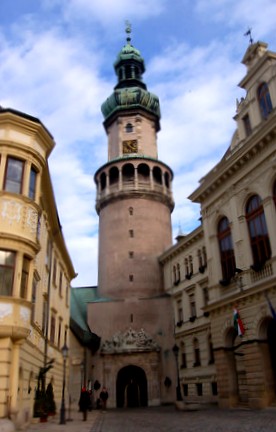 During
the late 17th century, a plague epidemic killed half of the population of Sopron and, in 1676, a huge fire devastated the
city, damaging many of the houses of the nobility. An essentially new town was born in the next few decades,
with Baroque buildings replacing the medieval houses. It was in that period that Sopron became the seat of the comitatus
Sopron and the Firewatch Tower was completed. The Firewatch Tower (see right) is 60 meters (195 feet) tall, with 200 steps
in a narrow circular staircase. Its square base was built on a Roman gate in the 12th century, with the fire watch feature,
the cylindrical middle and arcaded balcony being from the 16th century and the baroque spire topping it in 1681. After the
Ottomans left the country, the castle trenches were filled and became vegetable gardens and the castle moat was replaced by
the Várkerület (Castle circle) roads. Despite the population losses to plague and fire, the town grew to more than 11,000
inhabitants, all with the right of citizenship, by the end of the 1700s. During
the late 17th century, a plague epidemic killed half of the population of Sopron and, in 1676, a huge fire devastated the
city, damaging many of the houses of the nobility. An essentially new town was born in the next few decades,
with Baroque buildings replacing the medieval houses. It was in that period that Sopron became the seat of the comitatus
Sopron and the Firewatch Tower was completed. The Firewatch Tower (see right) is 60 meters (195 feet) tall, with 200 steps
in a narrow circular staircase. Its square base was built on a Roman gate in the 12th century, with the fire watch feature,
the cylindrical middle and arcaded balcony being from the 16th century and the baroque spire topping it in 1681. After the
Ottomans left the country, the castle trenches were filled and became vegetable gardens and the castle moat was replaced by
the Várkerület (Castle circle) roads. Despite the population losses to plague and fire, the town grew to more than 11,000
inhabitants, all with the right of citizenship, by the end of the 1700s. In the 1800s, the Jews were allowed to return and the town expanded beyond the four quarters (Viertels), into outer districts beyond the walls erected in the 17th century. These areas were called Front-town (Vorstadt), in order to distinguish them from the quarters inside the outer walls. Sopron did not participate significantly in the Hungarian Revolution of 1848 (which grew into a war for independence from the Austrian Empire ruled by the Habsburg monarchy). As a result, when the revolution was suppressed, the town became the centre of the Trans-danubian District, managing the financial, military and constabulary affairs of nine former counties. In 1850, a railway between Sopron and Nagykanizsa was established; however, the city missed out on the coveted railway line connecting Budapest and Vienna. After the establishment of the Austro-Hungarian Empire, Sopron re-gained her position as county capital. 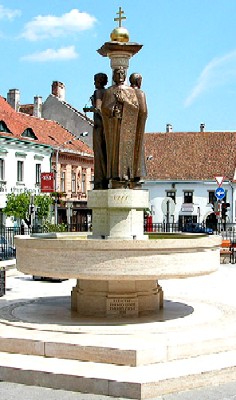 After
WW-I, a significant portion of Western Hungary was awarded to Austria by the Treaty of Saint-Germain-en-Laye,
territory which became Burgenland and was to include the Sopron járás. However, as a result of a plebiscite held on 14
December 1921, Sopron and the area around it remained Hungarian and the town was awarded the prestigious Latin title of
"Civitas Fidelissima" (the most allegiant town; Hungarian: A Leghuségesebb Város) by the Hungarian government. Some
historians argue that the town had already acquired this title in the decree of László IV in 1277, thus the title of 1921
was only a renewal of the former one, however, the medieval decree does not include the words "Civitas Fidelissima."
Regardless, the anniversary of the plebiscite is still a city holiday. This event is also commemorated in the Fountain of
Faith memorial (see right) via a statue of Mihály Sopronyi Thurner, who held the office of Mayor between 1918 and 1941
and was influential during the preparations for the referendum. As a sign of his respect and love for the city, he took up
the middle name 'Sopronyi' at the beginning of the 1930s. After
WW-I, a significant portion of Western Hungary was awarded to Austria by the Treaty of Saint-Germain-en-Laye,
territory which became Burgenland and was to include the Sopron járás. However, as a result of a plebiscite held on 14
December 1921, Sopron and the area around it remained Hungarian and the town was awarded the prestigious Latin title of
"Civitas Fidelissima" (the most allegiant town; Hungarian: A Leghuségesebb Város) by the Hungarian government. Some
historians argue that the town had already acquired this title in the decree of László IV in 1277, thus the title of 1921
was only a renewal of the former one, however, the medieval decree does not include the words "Civitas Fidelissima."
Regardless, the anniversary of the plebiscite is still a city holiday. This event is also commemorated in the Fountain of
Faith memorial (see right) via a statue of Mihály Sopronyi Thurner, who held the office of Mayor between 1918 and 1941
and was influential during the preparations for the referendum. As a sign of his respect and love for the city, he took up
the middle name 'Sopronyi' at the beginning of the 1930s. However, not all effects of the referendum vote were positive, for either Burgenland or Sopron. Burgenland lost its capital and a major transportation hub, plus part of Vienna's "kitchen garden." And Sopron became an isolated border town, which had serious social and economic consequences for many years. As noted above, the town lost its major market, Vienna, but tried to counter this by developing a textile industry and tourism. In the interwar period, there was increased ethnic tension and Germans in Sopron (and elsewhere in Hungary) came under heavy pressure to use the Hungarian language and to 'magyarise' their names. During WW-II, Sopron was invaded by German troops and suffered heavy bombardments (which luckily spared the central city). The Nazis and their Hungarian allies transported to death camps almost all of Sopron's Jewish citizens and some of its left-wing workers. Then it was invaded by Soviet troops in 1945 and so found itself on the wrong side of the Iron Curtain when the war ended. Sopron's German-speaking population was deported during the post-war years and, in 1950, the city lost the prestige of being a county seat. Worse yet, the town was located in the so-called "border-line," thus could only be visited with special permission during the Soviet era. Further, given its closeness to the Iron Curtain, even regular travelers in the area were frequently harassed on trains, public roads, etc. Over the years, the access difficulties led to a regression of industry and commerce and forced mines in the area to close. Luckily, the Baroque inner town was still well-preserved so, even before the Iron Curtain came down, Sopron initiated regular cultural events to show off her hidden beauties to visitors. 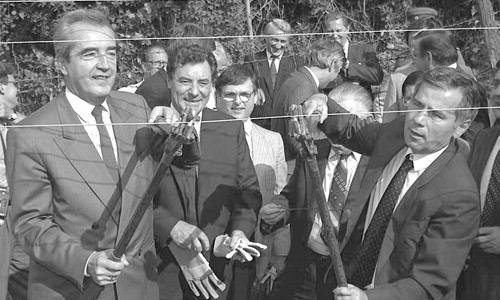 By
1989, Hungary was openly rebelling against the presence of the Iron Curtain and, on June 27 1989, Austria's foreign
minister, Alois Mock, and his Hungarian counterpart, Gyula Horn, together cut through the border fence near Sopron in a
symbolic act to highlight Hungary's decision to dismantle its installations along the border. Twenty-two days later, on
August 19th, a Pan-European Picnic was held in nearby Fertörákos, where a border gate on the road from Sankt Margarethen im
Burgenland to Sopronkohida was to be opened for three hours. Hundreds of East-Germans, who had been invited to the picnic,
fled through the border to Austria. In the months to come, over 70,000 people would flee to the West across Hungary's
border. By
1989, Hungary was openly rebelling against the presence of the Iron Curtain and, on June 27 1989, Austria's foreign
minister, Alois Mock, and his Hungarian counterpart, Gyula Horn, together cut through the border fence near Sopron in a
symbolic act to highlight Hungary's decision to dismantle its installations along the border. Twenty-two days later, on
August 19th, a Pan-European Picnic was held in nearby Fertörákos, where a border gate on the road from Sankt Margarethen im
Burgenland to Sopronkohida was to be opened for three hours. Hundreds of East-Germans, who had been invited to the picnic,
fled through the border to Austria. In the months to come, over 70,000 people would flee to the West across Hungary's
border. This event, the opening of the border (which quickly led to the fall of the Iron Curtain and the reunification of Germany), is the third event commemorated in Sopron's Fountain of Faith memorial, this one by a statue of a woman symbolizing liberty and holding a piece of the iron curtain in her hand. Sopron is rightfully proud of its faithfulness, both to country and to the spirit of freedom. 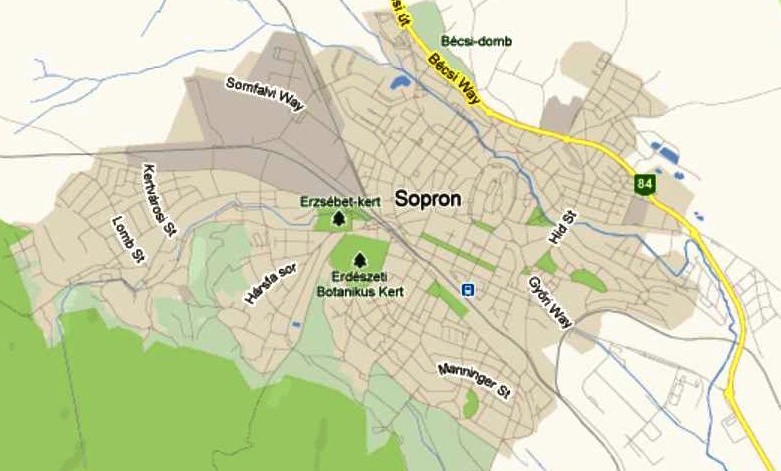 Sopron, now a town of nearly 61,000 residents, endeavors to become a venue of high quality tourism, entertainment, wine-growing and conferences, of which I will tell you more in the coming section. As you can see from the map above, it has expanded greatly to the southwest of the earlier core city. Sopron Today Sopron's economy has immensely benefited from the European Union. Having been a city close to nowhere for so long, Sopron has now re-established full trade relations with nearby Austria. Furthermore, after being suppressed during the Cold War, Sopron's German-speaking culture and heritage are now recognized again. As a consequence and due to its proximity to the Austrian frontier, many of the city's street-and traffic-signs are written in both Hungarian and German, making it an officially bilingual city. Visitors admire 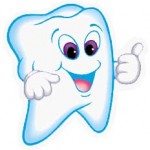 the
large number of buildings that reflect medieval architecture—rare in historically war-torn Hungary. Sopron receives many
visitors from Vienna (70 km away), and from Bratislava, Slovakia (77 km away), as well as from the United States, Great
Britain, The Netherlands, Japan, and Scandinavia. Many people visit to take advantage of the excellent low-cost dental
services offered: Sopron boasts so many dental clinics—more than 300—that the city is known as the "dental capital of the
world." the
large number of buildings that reflect medieval architecture—rare in historically war-torn Hungary. Sopron receives many
visitors from Vienna (70 km away), and from Bratislava, Slovakia (77 km away), as well as from the United States, Great
Britain, The Netherlands, Japan, and Scandinavia. Many people visit to take advantage of the excellent low-cost dental
services offered: Sopron boasts so many dental clinics—more than 300—that the city is known as the "dental capital of the
world."As for the BB, we have 46 members who list Sopron (Ödenburg) as a village of interest and 33 more with interest in the other villages of the current Sopron járás: Ágfalva (Agendorf), Balf (Wolfs), Fertöbóz (Holling), Fertörákos (Kroisbach), Harka (Harkau), Kópháza (Kohlnhof), Nagyczenk (Großzinkensdorf), Sopronbánfalva (Wandorf). There are many tourist attractions. First among these is the Firewatch Tower near the main square (the Fo tér), which served both as its name implies but also to warn the city of approaching foreign soldiers. The tower guards also kept the time by sounding their trumpets from the balcony every quarter of an hour, then, from the 16th century, they managed the tower clock. They also showed their musical talent by providing music at weddings, funerals, and town festivals. The tower is also a symbol of faithfulness with a Baroque door-frame and a sculptural group entitled "The people of Sopron paying homage to the mythological figure of Hungaria" around and above the "Gate of Faith" in the base of the tower. 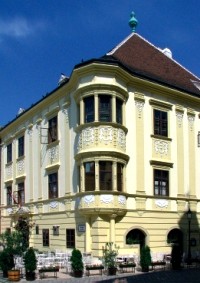 The Storno House and its exhibition on the first floor on the history of Sopron County is another attraction on the main square. It is a castle-like Baroque corner house that was once the property of the Haberleiter family and provided accommodation for King Matthias in 1482–83. The building hosted two concerts by Franz Liszt, in 1840 and 1881, and was home for Sopron’s first apothecary, the Black Elephant (Fekete Elefánt), in the 15th century. The rooms, decorated with antique furniture as well as the works of family members, give a true picture of interior design at the end of the 19th century. The collection comprises valuable items of furniture, weaponry, china and glass art, which can be seen on the second floor, where the Storno family lived from 1875 to 1984. The Fabricius House features a Roman bath in the basement, a Gothic hall, a loggia in the courtyard and Gothic and Baroque cellars. The house is named after Endre Fabricius, who was mayor and magistrate and purchased the house in 1806. The building hosts three exhibitions. The cellar contains remains from Roman Scarbantia: headstones, altar stones, statues, sepulchral urns of stone, and sarcophagi. Two floors at the back of the building host an archeological exhibition, "Three-thousand Years on the Amber Road." The rooms on the first and second floors show the changes in interior design between the 17th and 18th centuries, by presenting objects and furniture of those times. 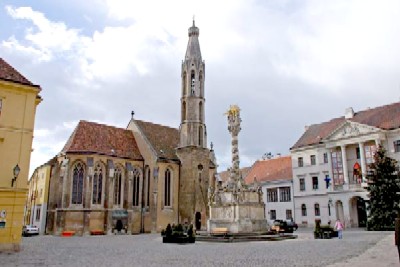 The Goat Church (A Kecske-templom) was originally a Franciscan monastery in the centre of town. Around 1280, they built a church, popularly known as "the goat church", which is an outstanding example of Hungarian Gothic architecture. During the centuries the church was the site of coronations and numerous parliamentary sessions. Its tower and masterpieces by fresco painters and other artists, the lancet windows, and the Capistran pulpit are highly admired. The most important building on the Forum of Scarbantia, the Capitolium, was discovered in the winter of 1893, during the construction of the City Hall. The exact size and position of the Forum was determined by excavations in the 1960s when the pedestals of three bronze equestrian statues were found on the southern part of the square. and altars to different gods were discovered on the sides of the Forum. 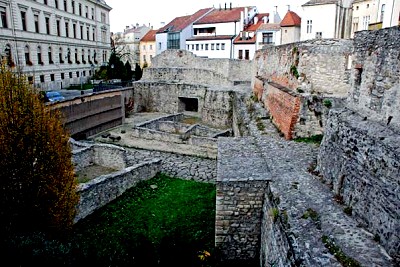 The
temples of the three main gods – Jupiter, Juno and Minerva - were situated at the highest point of the town. The exhibition
of the monumental architectural work recalls life in the former Roman town. The
temples of the three main gods – Jupiter, Juno and Minerva - were situated at the highest point of the town. The exhibition
of the monumental architectural work recalls life in the former Roman town.The National Lutheran Museum provides the history of the Lutheran congregation in Sopron dating back to the time of the Reformation in Hungary. The Lutheran church of Sopron is the oldest, most outstanding architectural work of the period after the issue of the Edict of Tolerance. There are frequent organ concerts here, as the huge instrument has an unforgettable tone. The treasury of the church has a rich collection of Hungarian and foreign masterpiece ecclesiastical objects: communion goblets, jugs, ciboria, candlesticks and altar cloths. The Archives holds documents from the middle of the 16th century onwards and the library hosts over 6000 books, handwritten Bibles and basic theological works that are available for interested researchers. 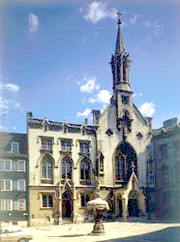 The neo-Gothic Ursuline Catholic Church (Orsolya-templom) is an impressive architectural monument of the past century. Its Catholic Convent, in the oratory of the former Ursuline monastery, hosts the Collection of Roman Catholic Church Art. The convent collected, and thereby saved, damaged objects of church art, renewed them, and made them available for art historians, researchers and the public. The material includes Baroque art and sacral objects, plus earlier and 19th century relics. The goblets, reliquaries, crucifixes, ceremonial and baptizing pitchers and crosiers, the sculptures and the intact parts of the altars, and the Baroque vestments and robes bear evidence of the richness of previous centuries. There are many additional places of interest in Sopron beyond these but, rather than describing them, I will only list them below. • Széchenyi Square and Flag of Loyalty • Eggenberg House (early Lutheran worship place with interesting architecture / grounds) • City Hall (eclectic, 1895) 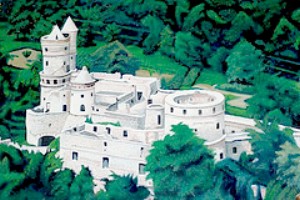 • Taródi Castle (fairytale "medieval" castle built starting 1950) • Two Moors House (baroque, made from two 17th-century peasant houses) • Chemist's Museum (declared a national monument by Louis II in 1525) • Gambrinus House (old city hall) • Other remains from the town's earlier Jewish community • The Holy Trinity Statue (a masterpiece of the Hungarian baroque) • Central Museum of Mining • Forestry Collection • József Soproni Horváth collection ("the great painter of Sopron") • Zettl–Langer collection (ceramics, paintings and furniture) • Bakery Museum • The Lábasház (an arcaded house in Orsolya Square) Simply walking the streets of the inner town will reveal many medieval houses, with gables and spacious courtyards, along interesting, narrow streets filled with architectural rarities built in Gothic, Baroque and Renaissance styles, complete with historical monuments and local culture. There is the medieval atmosphere of the squares, the delicately fashioned balconies, and the arched gateways with their Gothic sedilia (stone seats, recessed into walls) and the cheerful, inviting wine cellars. From many areas one can catch a glimpse of the old town walls. The Esterházy, Erdödy, Széchenyi and Zichy-Meskó mansions witness that the Sopron area was a highly popular place of residence also among the families of Hungarian aristocracy. Then there are the collections of local history, scientific and industrial history, and art and religious items that are displayed in a total of 23 permanent exhibitions in Sopron. Further out, into the surrounding Sopron járás, there is Brennbergbánya, the first coal mine of Hungary, which supplied charcoal to the industry of the region from 1752 to 1952 (and was one of the factors motivating Hungary to retain Sopron in 1921). The Lövérek, a forested, hilly area on the southwest edge of town, with the Károly-kilátó (Charles Lookout Tower), that offers a pleasant walk or a popular place for serious hiking. The baroque Esterházy Palace in Fertod, the village museum of traditional houses in Fertoszéplak, the museum of the 'greatest Hungarian', István Széchenyi, in Nagyczenk, the Cave Theatre and the stone quarry (which supplied paving and building stone for the Romans) in Fertörákos, and the Maria Magdalena church at Bánfalva are other places of special interest. Sopron is also known for its annual festivals. Among the many are the following: • Spring Festival of Sopron (Soproni Tavaszi Fesztivál) held from late March into April, features music, cultural and theatre events presented by famous native and foreign artists. 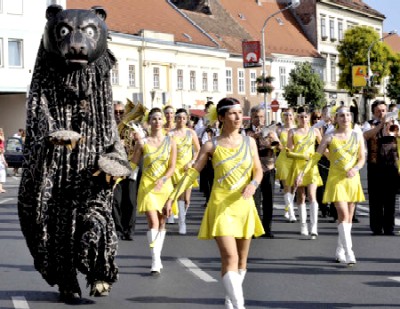 •
Festal Weeks of Sopron (Soproni Ünnepi Hetek) held from late June into July, features parades, theatre, music,
talent shows, costume (fairies and elves) competitions and fireworks. •
Festal Weeks of Sopron (Soproni Ünnepi Hetek) held from late June into July, features parades, theatre, music,
talent shows, costume (fairies and elves) competitions and fireworks.• VOLT festival (the festival of electronic music) held early July in the Lövérek, is a four-day multicultural festival with 15 stages and approximately 200 programs: concerts, DJs, theater shows and performances of a wide variety of musical styles: rock, pop, jazz, hip-hop, electro, world music, etc. Had nearly 100,000 attendees last year. • Civitas Cellar Theater (Civitas Pinceszínház), features repertory theater, mime, drama, comedy, cabaret, absurd and children's pieces plus 150+ lectures each year in a medieval basement setting. • Early Music Days Festival in June is a forum for Hungarian and foreign historical music, performers and ensembles; held at the Franz Liszt Conference and Cultural Centre (Liszt Ferenc Muvelodési Központ), a comprehensive conference center that also utilizes its auditorium spaces for concerts. • Sopron Wine Festival is mainly about the wine, with opportunities to taste wines and discuss viniculture, but also provides musical entertainment and good foods to pass the evenings. • Pan-European Picnic, an annual commemoration on August 19th of the Pan-European Picnic, the meeting of European nations that takes place in Sopronpuszta, at the scene of the border opening in 1989. The event popularizes the idea of a common Europe without frontiers. Wine Production Sopron is a significant wine producing region, one of the few in Hungary to make both red and white wines. Grapes include Kékfrankos for red wine and Traminer (Gewürztraminer) for white wine. Not surprisingly, its climate is similar to the 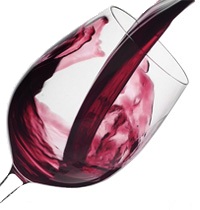 Burgenland wine region so
several winemakers make wine in both countries. Blue Frankish, Traminir, Pinot Noir and Green Veltelini are well-known
Sopron wines. Visitors should not miss trying Kékfrankos, the most famous of the Sopron wines. Mentioned above, the Sopron
Wine Festival is renowned through out Europe and is attended by both wine experts and interested public. Burgenland wine region so
several winemakers make wine in both countries. Blue Frankish, Traminir, Pinot Noir and Green Veltelini are well-known
Sopron wines. Visitors should not miss trying Kékfrankos, the most famous of the Sopron wines. Mentioned above, the Sopron
Wine Festival is renowned through out Europe and is attended by both wine experts and interested public.The region is one of the oldest wine-growing regions of historical Hungary, with traditions based on a wine culture created by the Celts and the ancient Romans. In the 14th century, it was considered one of the most important wine-growing regions of the country, having trade connections that spanned national borders. Unlike in other regions, the wine cellars are traditionally below the winemakers house inside the city, rather than at their hillside wineries. This provided more safety and protection for the winemakers. The most valuable wine-growing areas are the hillsides near Lake Fertö (Neusiedlersee), with climatic conditions and the salinity of the soil and water contributing to the uniqueness of the region's wines. In the time of the Monarchy, the grape-growing areas around the lake formed a single wine-growing region under the name Sopron-Ruszt-Pozsony and grew similar types using similar methods. The epidemics destroying the grape plantations and the "storms of history" gave individual direction to parts of the region. White grapes dominated the area around Sopron until the end of the 1800s. The characteristic type of the region now, the Blue Frankish grape, came to the fore after the 1890s. It is a peculiarity of the region that the climate here is advantageous for the production of late-harvested sweet wines as well. These wine types are not new in this area; their presence goes back to the 16th century. Jewish Sopron Sopron no longer has an active Jewish community, however, there are relics of their various times in Sopron. Hannes Graf, on his Spirit of Gradišće - Őrvidék Group website has three articles about Jewish Synagogues in Sopron. Rather than reprint them here, I'll provide links to each article: Old Synagogue, Uj utca 11 (a medieval synagogue built about 1370) Old Synagogue, Uj utca 22 (an early gothic synagogue built about 1300) Old Synagogue, Papret (an orthodox synagogue built in the early 1890s) All are no longer actively used as synagogues. |
3) ETHNIC EVENTS LEHIGH VALLEY, PA Thursday-Sunday, Dec. 1-18: Christkindlmarkt at SteelStacks in Bethlehem. Info: www.christmascity.org/christkindlmarkt/ Friday, Dec. 2: Maria & John at the Lancaster Liederkranz. Info: www.lancasterliederkranz.com Friday-Sunday, Dec. 2-4: Christkindlmarkt at the Reading Liederkranz. Info: www.readingliederkranz.com Saturday, Dec. 3: Lancaster Liederkranz Chorus Christmas Concert at Zion Lutheran Church in Landisville. Info: www.lancasterliederkranz.com Sunday, Dec. 4: Emil Schanta Band at the Coplay Sängerbund. Info: www.coplaysaengerbund.com Tuesday, Dec. 6: German-English Advent Singstunde at Central Moravian Church (Old Chapel) in Bethlehem. Info: www.moravianmusic.org/german-english-advent-singstunde-4/ Friday, Dec. 9: Kermit Ohlinger at the Reading Liederkranz. Info: www.readingliederkranz.com Saturday-Sunday, Dec. 10-11: German Christmas Market at Holy Ghost Roman Catholic Church in Bethlehem. Info: www.holyghost-church.org/ Sunday, Dec. 11: Christkindlmarkt at the Lancaster Liederkranz. Info: www.lancasterliederkranz.com Sunday, Dec. 11: Dave Betz Band at the Coplay Sängerbund. Info: www.coplaysaengerbund.com Sunday, Dec. 18: Josef Kroboth Orchestra at the Coplay Sängerbund (Christmas Dance). Info: www.coplaysaengerbund.com Sunday, Dec. 18: German Christmas Service at First St. John's Evangelical Lutheran Church in York. Choral music by the Lancaster Liederkranz Hobbychor. Info: www.firststjohns.org Friday, Dec. 23: Kermit Ohlinger at the Reading Liederkranz. Info: www.readingliederkranz.com Friday, Dec. 30: Kermit Ohlinger at the Reading Liederkranz. Info: www.readingliederkranz.com Saturday, Dec. 31: Silvesterfeier at the Coplay Sängerbund. Music by the Emil Schanta Band. Info: www.coplaysaengerbund.com/wp-content/uploads/2022/11/Silvester22-2.pdf Saturday, Dec. 31: New Year’s Eve at the Evergreen Heimatbund in Fleetwood. Music by the Josef Kroboth Band. Info: www.evergreenclub.org Saturday, Dec. 31: Silvesterball at the Reading Liederkranz. Info: www.readingliederkranz.com NEW BRITAIN, CT Friday-Sunday, 1-8 pm: Biergarten is open. Austrian Donau Club, 545 Arch Street. ST. LOUIS, MO (none) UPPER MIDWEST (none) |
4) BURGENLAND EMIGRANT OBITUARIES Margaret Hudak (née Wölfinger)  Margaret H. Hudak, 79, of Bethlehem,
Pennsylvania passed away peacefully on Thursday, November 3, 2022, at Lehigh Valley Hospital-Inpatient Hospice, Allentown,
surrounded by her loving family. Margaret H. Hudak, 79, of Bethlehem,
Pennsylvania passed away peacefully on Thursday, November 3, 2022, at Lehigh Valley Hospital-Inpatient Hospice, Allentown,
surrounded by her loving family. Born June 27, 1943, in Pornóapáti (Pernau), Hungary, she was the daughter of the late Edward and Mary (Schmalzel) Wölfinger. Margaret worked in the Operations Department at Careerlink, formerly Private Industry Council, until retiring in 2011 after 32 years. She was a member of Queenship of Mary Catholic Church in Northampton. Survivors: children, Frank S. Hudak, Lisa Cavallo and husband, Angelo (Bacci), and Michael Hudak and wife, Megan; grandchildren, Frank, Nicholas, Brooke, Damon, Dominik, Madeline, Sofika, Ava, and Francesca; and sister, Mary Legath. Margaret was predeceased by her sister, Pauline Macchia. Services: A Mass of Christian Burial will be celebrated on Saturday, Nov. 12th at 10:00 a.m. in Queenship of Mary Church, 1324 Newport Ave., Northampton. Family and friends may gather Saturday morning from 9:00 to 9:45 a.m. in the church. Interment will follow in Our Lady of Hungary Cemetery, Northampton. Arrangements are under the direction of Reichel Funeral Home, Northampton. Online condolences may be offered at www.reichelfuneralhome.com. In lieu of flowers, memorial contributions may be presented to the church in loving memory of Margaret. Published by Morning Call on Nov. 6, 2022 Anna Giedl (née Ivanschitz)  Anna Giedl, 90 years, formerly of
Whitehall, Pennsylvania, died November 27, 2022 at her residence at Cedarbrook Nursing Home in Allentown. She was the wife
of the late Joseph Giedl, who passed away in 2018. Anna Giedl, 90 years, formerly of
Whitehall, Pennsylvania, died November 27, 2022 at her residence at Cedarbrook Nursing Home in Allentown. She was the wife
of the late Joseph Giedl, who passed away in 2018.Born in Fertorákos (Kroisbach) Hungary, she was the daughter of the late Mathias and Maria (Adler) Ivanschitz. Anna retired from the garment industry where she was employed as a sewing machine operator. She was a member of St. John the Baptist Roman Catholic Church in Whitehall and also the Coplay Saengerbund, where she enjoyed dancing and listening to Polka music. She will be missed by all who knew and loved her. She will be lovingly remembered by her daughter Arlene L. Stephens and her husband Kevin, sons John and Ronald; 6 grandchildren and 1 great grandchild. There will be a calling period on Friday, December 2, 2022 from 10-11:00 a.m. at Brubaker Funeral Home, Inc. of Coplay, 327 Chestnut Street. Coplay, PA 18037. An 11:00 a.m. funeral service officiated by Monsignor G. Gobitas will follow in the funeral home. Interment to follow at St. Peter's R.C.C. Cemetery in Coplay. Online condolences for the family may be recorded at www.brubakerfuneralhome.com. Brubaker Funeral Home, Inc. of Coplay is entrusted with arrangements. Published by Morning Call on Nov. 29, 2022 |
| END OF NEWSLETTER (Even good things must end!) |
|
Burgenland Bunch Newsletter, copyright © 2022 by The Burgenland Bunch |
 News
News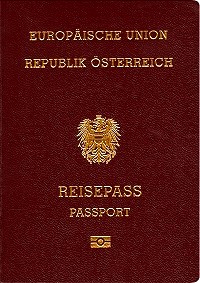 The Austrian citizenship law is
one of the most restrictive in Europe, if not in the world. Two citizenships are not permitted, so when Austrians abroad are
forced to accept citizenship in a host country for professional or family reasons, they lose their Austrian citizenship.
The Austrian citizenship law is
one of the most restrictive in Europe, if not in the world. Two citizenships are not permitted, so when Austrians abroad are
forced to accept citizenship in a host country for professional or family reasons, they lose their Austrian citizenship.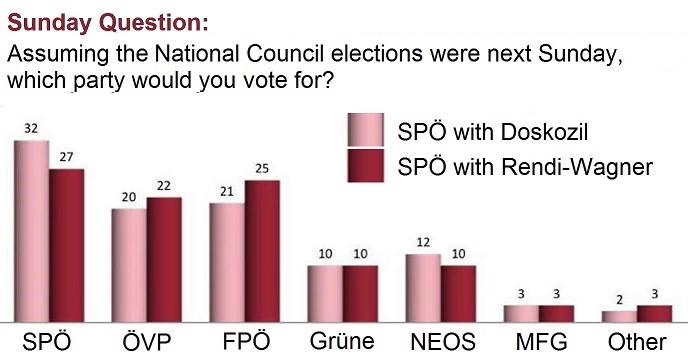
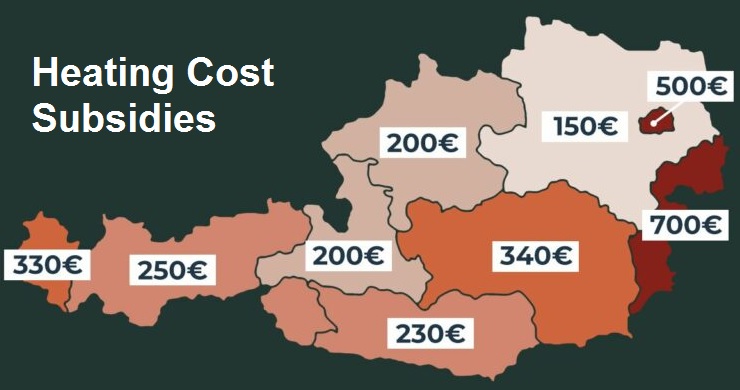 The
three federal states of Lower Austria, Upper Austria and Salzburg bring up the rear in terms of the amount of heating cost
subsidies (see chart). And they have one thing in common: All three states are governed by ÖVP governors.
The
three federal states of Lower Austria, Upper Austria and Salzburg bring up the rear in terms of the amount of heating cost
subsidies (see chart). And they have one thing in common: All three states are governed by ÖVP governors.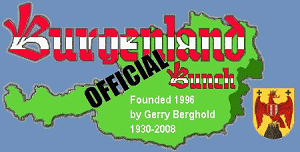 The
Facebook Bunch (from Vanessa Sandhu):
The
Facebook Bunch (from Vanessa Sandhu): Update
for book "The Burgenländer Emigration to America": Here is this month's update on purchases of the English issue of
the 3rd edition of Dr. Walter Dujmovits' book "Die Amerika-Wanderung Der Burgenländer."
Update
for book "The Burgenländer Emigration to America": Here is this month's update on purchases of the English issue of
the 3rd edition of Dr. Walter Dujmovits' book "Die Amerika-Wanderung Der Burgenländer."
